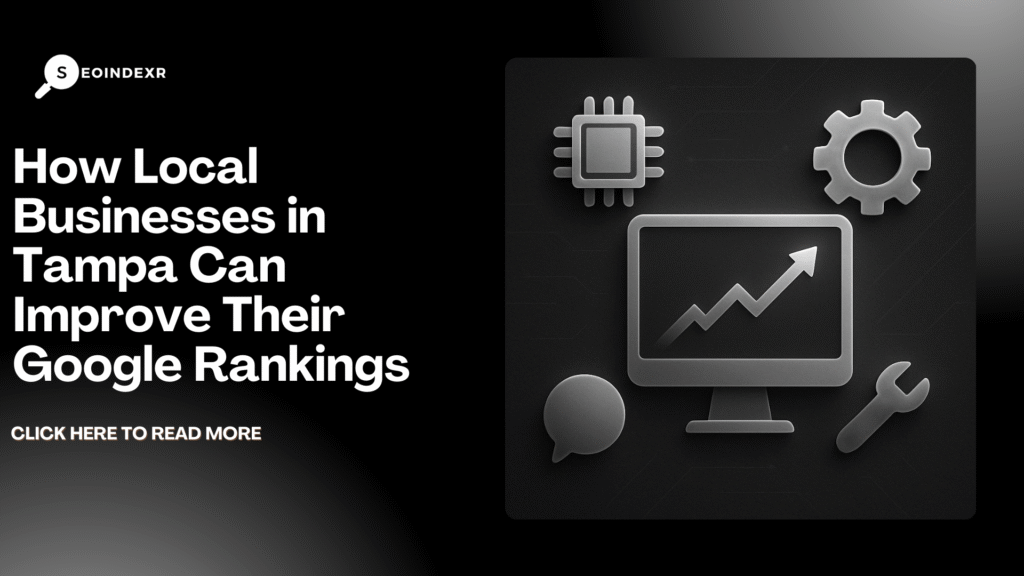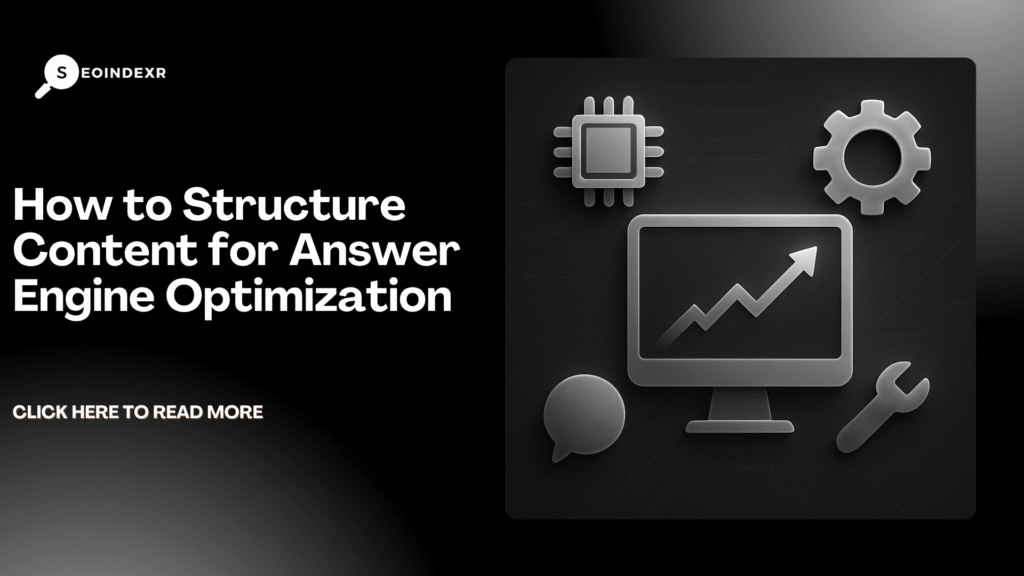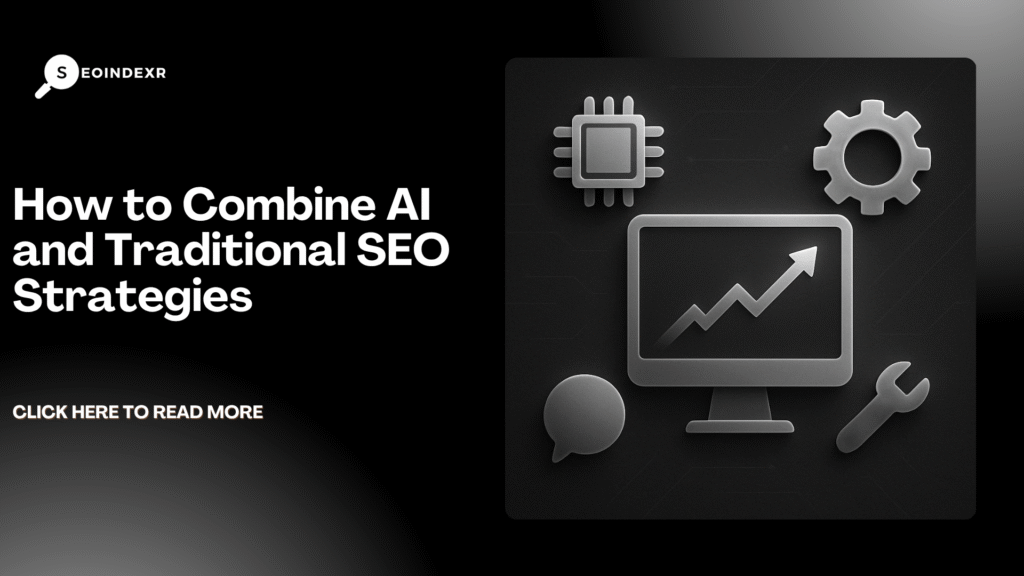Navigating SEO’s AI Era: Top Trends and Strategies for 2025

Search engine optimization is entering a new era as artificial intelligence permeates every layer of discovery. Instead of just focusing on rankings in a list of ten links, brands must think about how their content appears in conversational assistants, generative summaries and interactive search results. Large language models such as OpenAI’s ChatGPT, Anthropic’s Claude, Google’s Gemini and Perplexity have become everyday tools for consumers seeking answers, and Google’s AI Overviews overlay concise summaries on many results pages. This trend means fewer clicks for some informational queries, but it also gives marketers new surfaces to be discovered. Optimizing for this environment requires a holistic approach that combines technical SEO, content depth, brand recognition and engagement signals. In this comprehensive article we’ll explore key trends shaping SEO in the second half of 2025—from generative engine optimization (GEO) and AI adoption statistics to schema markup, listicle strategies, topical authority and link building. We’ll also look at search engine updates and provide actionable tactics you can implement today to stay ahead in SEO’s AI era. Understanding SEO vs GEO in 2025 Traditional SEO focuses on ranking web pages in search engine result pages (SERPs). However, as generative AI becomes integrated into search, a complementary discipline known as generative engine optimization (GEO) is emerging. GEO is the practice of making your brand or content more likely to be surfaced by AI assistants and large language models. These models do not index the web in the same way search engines do; they rely on training data, citations and structured knowledge to generate answers. To succeed in GEO you must think about how your brand appears in third‑party sources (like news articles, Wikipedia, forums and listicles) that language models reference, as well as how your content is structured for machine understanding. Importantly, SEO and GEO are not mutually exclusive; many best practices overlap. Technical optimizations like fast page load, descriptive metadata and mobile friendliness remain essential for search ranking and help AI systems interpret content. High‑quality, comprehensive content also performs well in both search and AI assistants. The key difference is emphasis: GEO prioritizes building a strong external footprint so that when a model generates a response it draws upon your brand as an example. It requires public mentions, robust internal knowledge graphs and strategic partnerships. As 2025 progresses, most businesses will need to integrate both SEO and GEO into a unified strategy to capture traffic from search engines and visibility within AI‑generated answers. AI adoption is reshaping SEO workflows AI is no longer an experimental technology for marketers—it’s embedded in everyday workflows. Recent industry data shows that more than half of marketers now use generative AI for SEO tasks such as writing blog posts, generating meta descriptions, analyzing search intent and performing competitive research. According to one 2025 survey, 56 percent of marketers already use generative AI in their SEO processes and 83 percent of large organizations report measurable SEO gains from AI integration. The same research found that AI‑driven SEO campaigns can boost organic traffic by 45 percent and increase e‑commerce conversions by 38 percent. With the AI SEO tools market projected to grow from about $1.2 billion in 2024 to $4.5 billion by 2033, adoption will only accelerate. The impact of AI extends beyond content generation. Tools powered by machine learning now automate keyword clustering, identify gaps in topical coverage, personalize web experiences and even help with internal linking. For example, AI writers can produce first drafts, leaving editors to refine tone and ensure accuracy. Analytics tools can flag declining keywords and suggest new topics based on trends. While some fear that AI will replace SEO professionals, the reality is that these technologies augment human expertise and free time for strategy. As 69 percent of SEO specialists expect their roles to be disrupted by generative AI, those who embrace automation and focus on strategic tasks like content architecture, brand storytelling and technical oversight will thrive. Schema markup becomes a focal point Structured data, or schema markup, has long been an SEO best practice because it helps search engines understand the type of content on a page. In 2025 it’s becoming even more important as large language models ingest structured data to ground their responses. Engineers from both Bing and Google have publicly explained that their generative AI systems rely on schema to interpret web content because it’s computationally cheaper than parsing unstructured text. Adding schema sends explicit signals about the purpose of your page—whether it’s an FAQ, product, recipe, how‑to guide or data set—and increases your chances of being used as a source for AI answers. To leverage this trend, start by auditing which schema types are most relevant to your niche. Frequently used schemas like FAQ, Q&A, HowTo and Article are widely supported, but there are also specialized types like Carousel for collections of items, DataSet for tables and Organization or Author for verifying who created the content. Mark up your pages using JSON‑LD and test them with tools like Google’s Structured Data Testing Tool. Make sure the structured data matches the visible content to avoid spammy signals. As generative AI continues to rely on structured inputs, thorough and accurate schema will be a differentiator. Listicles, brand mentions and citation visibility One surprising outcome of the generative AI boom is the renewed importance of listicles—articles that rank or round up products, tools or services within a category. Studies in 2025 show that listicle articles are cited by language models more often than other formats because they offer concise comparisons and authoritative recommendations. When ChatGPT or another AI tool generates an answer about “best email outreach software,” it frequently draws from curated lists compiled by industry blogs. As AI adoption grows, being mentioned on these lists can improve both traditional SEO (via backlinks) and GEO (by being referenced in AI responses). To capitalize on this, businesses should aim to create high‑quality, unbiased listicles within their own niches and also seek placement on reputable lists. Outreach to publishers, niche bloggers and SaaS review sites can help secure spots. When producing your own
Latest SEO & AI Search Updates – 11 August 2025

AI Mode Rolls Out and Impacts Search Behavior Google’s new AI Mode, sometimes called the Search Generative Experience, is gradually rolling out in the U.S. and UK. Powered by the Gemini 2.5 model, the feature responds to complex queries with conversational snapshots so users don’t need to click through multiple pages. Early data from Similarweb indicates that click-through rates on AI-powered results pages can drop from around 25 % to just 5 %, suggesting businesses may receive fewer organic visits. Despite these concerns, Google maintains that AI search is driving more overall queries and better-quality clicks. Adoption is still modest—only about 0.1 % of UK users opted into AI Mode on July 28, but usage grew to 9.2 % by August 1 before dipping to 6.3 % by August 3. Google has started pitching AI Mode ads to marketers and is issuing guidance on how to optimise content for AI summaries. OpenAI GPT‑5 on the Horizon Rumours continue to swirl about OpenAI’s next major model, GPT‑5. Reports say it will be fully multimodal—handling video and audio alongside text and images—and is expected to provide better reasoning, fewer hallucinations and a much larger context window, possibly up to one million tokens. OpenAI is also said to be working on more autonomous “agentic” capabilities that allow the model to plan and execute tasks with minimal instruction. Early hints suggest a phased rollout starting in August 2025. New Tools and Updates Microsoft has expanded its Bing Webmaster Tools. Site owners now have access to 24 months of search performance data, with filters for country and device plus trend lines for individual queries. These enhancements make it easier to spot long-term trends and refine SEO strategies. June 2025 Core Update and E‑E‑A‑T Google’s June 2025 core update finished rolling out on July 17 and placed more emphasis on expertise, experience, authority and trustworthiness (E‑E‑A‑T). Because AI‑powered “AI Overviews” often surface at the top of search results, many industries saw a spike in zero‑click searches. User‑generated content platforms benefited, while some niches experienced volatility. Ensuring that your content clearly demonstrates first-hand experience and cites trustworthy sources is now more important than ever. Privacy and Platform Moves OpenAI has removed the ability to share ChatGPT chats due to privacy concerns. Reddit, meanwhile, is investing heavily in search: the company says 70 million people use its internal search weekly, and its AI-powered “Reddit Answers” feature has grown fivefold to 6 million weekly users. The platform aims to become a major search destination and recently reported strong financial results. Actionable Tips for SEOs Monitor AI Mode adoption in your markets and test how your pages appear in AI snapshots. Focus on E‑E‑A‑T: produce content that showcases expertise and cites reliable sources. Use structured data (schema markup) to help search engines understand your content and improve your chances of appearing in AI summaries. Analyse long-term query trends using Bing Webmaster Tools’ extended 24-month data and Google Search Console’s latest reports. Stay alert for upcoming changes from OpenAI and Google; developments in GPT‑5 and AI search will continue to shape user expectations.
How Local Businesses in Tampa Can Improve Their Google Rankings

In today’s digital era, having a robust online presence is crucial for local businesses in Tampa aiming to attract more customers and enhance their visibility. One of the most effective ways to achieve this is by improving your Google rankings. This comprehensive guide explores actionable strategies to help Tampa businesses boost their online presence and connect with the local community. 1. Optimize Your Google Business Profile Your Google Business Profile (GBP) serves as a digital storefront, providing essential information about your business to potential customers. Optimizing your GBP is a foundational step in enhancing your local SEO. Claim and Verify Your Listing Ensure your business is listed on Google by claiming and verifying your profile. This process allows you to manage your business information, respond to reviews, and post updates. Accurate and up-to-date information builds trust with customers and improves your search visibility. Ensure NAP Consistency Consistency in your business’s Name, Address, and Phone number (NAP) across all online platforms is vital. Inconsistent information can confuse both search engines and customers, negatively impacting your rankings. Regularly audit your online listings to maintain uniformity. ([velvetinkmedia.com](https://www.velvetinkmedia.com/google-business-profile-optimization-tampa/?utm_source=openai)) Choose the Right Categories and Services Selecting accurate categories and listing your services under each category helps Google understand your business offerings, leading to better search rankings. For instance, if you run a digital marketing agency in Tampa, choose categories like “Marketing Agency” and “Website Designer.” Upload High-Quality Photos and Videos Visual content significantly influences customer engagement. Upload high-resolution images and videos showcasing your products, services, and premises. Listings with photos receive more engagement, including direction requests and website visits. Collect and Respond to Reviews Encourage satisfied customers to leave positive reviews on your GBP. Responding to reviews, both positive and negative, demonstrates your commitment to customer satisfaction and can enhance your credibility. 2. Leverage Local Citations and Directories Local citations—mentions of your business on other websites—play a crucial role in local SEO. They help search engines verify your business’s existence and relevance in the local area. List Your Business in Local Directories Ensure your business is listed in Tampa-specific directories such as the Greater Tampa Chamber of Commerce and Visit Tampa Bay. Consistent NAP information across these directories reinforces your business’s credibility. Target Industry-Specific Directories In addition to general directories, list your business in industry-specific directories relevant to your field. This targeted approach connects you with a more focused audience interested in your services. 3. Optimize Your Website for Local Search Your website is a central hub for your online presence. Optimizing it for local search ensures that potential customers find you when searching for services in Tampa. Incorporate Local Keywords Use location-specific keywords throughout your website’s content, meta descriptions, and title tags. Phrases like “best plumbers in Tampa” or “Tampa digital marketing agency” can improve your visibility in local searches. Create Location-Specific Pages If your business serves multiple areas within Tampa, create dedicated pages for each location. This approach allows you to tailor content to specific neighborhoods, enhancing relevance and searchability. Ensure Mobile Optimization With a significant number of local searches conducted on mobile devices, having a mobile-friendly website is essential. Implement a responsive design, optimize page load speeds, and ensure easy navigation to enhance user experience. 4. Build Local Backlinks Backlinks from reputable local websites signal to search engines that your business is trustworthy and relevant to the Tampa area. Partner with Local Businesses Collaborate with other Tampa-based businesses for cross-promotion opportunities. This could include guest blogging, joint events, or shared promotions, leading to valuable backlinks. Sponsor Community Events Sponsoring local events or community activities can result in mentions and backlinks from event websites, enhancing your local SEO. 5. Create Locally-Focused Content Developing content that resonates with the Tampa community can establish your business as a local authority and attract more visitors. Write About Local Events and News Share insights on local events, news, or topics of interest to Tampa residents. This approach not only provides value to your audience but also improves your relevance in local searches. Showcase Community Involvement Highlight your business’s participation in local events, sponsorships, or charitable activities. This demonstrates your commitment to the community and can enhance your brand image. 6. Implement Structured Data Markup Structured data markup, or schema markup, helps search engines understand your website’s content, improving your visibility in search results. Use Local Business Schema Implement schema markup to provide search engines with detailed information about your business, such as operating hours, location, and services offered. This can enhance your appearance in search results and increase click-through rates. 7. Monitor and Analyze Your SEO Performance Regularly tracking your SEO performance allows you to identify successful strategies and areas for improvement. Use Analytics Tools Utilize tools like Google Analytics and Google Search Console to monitor website traffic, user behavior, and keyword performance. This data can inform your SEO strategies and help you make data-driven decisions. Track Local Keyword Rankings Regularly check your rankings for local keywords to assess the effectiveness of your SEO efforts and adjust your strategies accordingly. Frequently Asked Questions (FAQ) 1. How long does it take to see improvements in Google rankings? SEO is a long-term strategy, and it may take several weeks or months to see significant changes in your Google rankings. Consistency and patience are key to achieving lasting results. 2. Is it necessary to hire an SEO expert for my Tampa business? While it’s possible to implement SEO strategies on your own, hiring an experienced SEO professional can provide expertise and save time, especially if you’re unfamiliar with SEO best practices. 3. How can I encourage more customer reviews? Ask satisfied customers to leave reviews after a purchase or service. Provide direct links to your review platforms and make the process as easy as possible. Responding to reviews can also encourage more customers to share their experiences. ([velvetinkmedia.com](https://www.velvetinkmedia.com/google-business-profile-optimization-tampa/?utm_source=openai)) 4. What are local citations, and why are they important? Local citations are online mentions of your business’s name, address, and phone number. They help search engines verify your business’s existence
How to Rank Your Colorado Springs Business on the First Page

In today’s competitive digital landscape, ranking on the first page of Google is essential for local businesses in Colorado Springs. With the city’s diverse neighborhoods and growing community, competition for visibility is fierce. This guide explores proven strategies tailored to Colorado Springs, helping your business secure top local search rankings. Understanding the Colorado Springs Local SEO Environment Colorado Springs offers a unique mix of opportunities and challenges for local business owners. Recent Google algorithm changes have reshaped local search rankings, making it more important than ever to keep SEO tactics updated. Businesses that embrace a proactive, location-focused strategy are more likely to capture targeted local traffic and convert customers. 1. Optimize Your Google Business Profile (GBP) Your Google Business Profile is the foundation of any local SEO strategy. A fully optimized GBP can boost your presence in Google Search and Google Maps results. Key Steps to Optimize Your GBP: Complete Your Profile: Ensure your business name, address, phone number, hours, and categories are accurate and consistent. Add High-Quality Photos: Businesses with appealing images often see up to 35% more clicks to their websites. Include photos of your storefront, products, services, and team. Post Regular Updates: Share events, promotions, or new offerings to keep your listing active and engaging. Encourage Reviews: Ask happy customers to leave reviews and respond to them promptly. Businesses with a high review count and consistent responses tend to rank better. 2. Use Local Keyword Targeting Incorporating location-specific keywords into your website content improves your relevance in local searches. Best Practices for Local Keywords: Research Location-Based Terms: Use tools like Google Keyword Planner to find searches such as “best pizza in Colorado Springs” or “Colorado Springs home repair.” Integrate Naturally: Include these terms in page titles, headings, meta descriptions, and body content without overstuffing. Cover Neighborhood Variations: Target smaller localities within the city, such as Briargate or Old Colorado City, to attract hyper-local customers. 3. Build Local Citations and Earn Backlinks Local citations and backlinks help Google verify your business’s authenticity and improve search authority. How to Build Citations and Backlinks: List in Local Directories: Add your business to platforms like Yelp, YellowPages, and the Colorado Springs Chamber of Commerce. Earn Local Backlinks: Collaborate with local news outlets, bloggers, or event organizers to get links pointing back to your website. Maintain Consistency: Ensure your Name, Address, and Phone Number (NAP) are identical across all listings. 4. Leverage Community Engagement and Social Media Active participation in community events and maintaining a strong social presence can indirectly boost local SEO. Engagement Tips: Participate in Local Events: Sponsor, host, or attend events to build brand recognition and gain mentions from local publications. Use Social Media Strategically: Post relevant local content, use geo-tags, and engage with followers to boost local awareness. Collaborate with Local Influencers: Partner with community influencers to reach a targeted audience. 5. Prioritize Mobile Optimization Since most local searches happen on mobile, a poor mobile experience can harm rankings and conversions. Mobile SEO Tips: Use a Responsive Design: Your site should adapt to all screen sizes. Speed Up Load Times: Compress images, remove unnecessary code, and use caching for faster loading. Simplify Navigation: Make it easy for users to find key information such as contact details, directions, or booking options. 6. Monitor and Adapt to Google Algorithm Updates Search engine algorithms change regularly, and staying updated is critical for maintaining rankings. Staying Ahead: Follow SEO News: Read industry blogs and join forums to stay informed. Track Performance: Use tools like Google Search Console to monitor changes in rankings and traffic. Adjust Quickly: If updates impact your site, adapt strategies to align with the latest best practices. Frequently Asked Questions (FAQ) 1. How long does it take to see results from local SEO?Typically, businesses begin seeing improvements in 3–6 months, though timelines vary depending on competition and strategy. 2. Should I hire a professional for local SEO?While DIY local SEO is possible, hiring an expert can save time and produce more effective results. 3. How can I get more customer reviews?Encourage reviews via follow-up emails, receipts, in-store QR codes, or direct requests after service. 4. What are local citations and why are they important?Local citations are online mentions of your business’s NAP. They help search engines confirm your legitimacy and location. 5. How do I make my site mobile-friendly?Use a responsive design, optimize speed, and ensure intuitive navigation for mobile visitors. 6. What local SEO mistakes should I avoid?Avoid outdated business info, generic location pages, slow mobile performance, and ignoring Google updates. 7. Is social media engagement important for rankings?Yes. While social signals may not be a direct ranking factor, social engagement boosts brand visibility and traffic. 8. How can I measure my local SEO success?Track keyword rankings, organic traffic, customer engagement, and conversions. 9. What role do backlinks play in local SEO?High-quality backlinks from relevant local sources improve authority and visibility.
SEO Strategies for Phoenix Companies to Dominate Local Search

In the ever-evolving digital landscape of 2025, Phoenix businesses must adopt advanced SEO strategies to maintain a competitive edge in local search results. This comprehensive guide explores the latest trends and actionable tactics to enhance your online visibility and attract a local clientele. Understanding the 2025 SEO Landscape The SEO environment is undergoing significant transformations, influenced by technological advancements and changing user behaviors. Key factors shaping SEO in 2025 include: Artificial Intelligence (AI) Integration: AI technologies, such as Google’s RankBrain and MUM, are revolutionizing search algorithms by emphasizing context and user intent over traditional keyword matching. This shift necessitates the creation of high-quality, contextually relevant content that addresses user needs effectively. turn0search0 Mobile-First Indexing: With mobile devices accounting for a substantial portion of internet traffic, Google prioritizes mobile-friendly websites in its ranking criteria. Ensuring your site is responsive and optimized for mobile users is crucial for maintaining search visibility. turn0search1 Voice Search Optimization: The proliferation of voice-activated devices has led to a surge in voice-based searches. Optimizing for conversational, long-tail keywords and implementing structured data can enhance your site’s performance in voice search results. turn0search0 Local SEO Emphasis: As users increasingly search for services “near me,” local SEO has become paramount. Claiming and optimizing your Google Business Profile, building local citations, and encouraging customer reviews are essential strategies for local search dominance. turn0search2 Video Content Dominance: Video content continues to engage users effectively, with platforms like YouTube and TikTok leading the charge. Incorporating video into your content strategy can boost engagement and improve search rankings. turn0search0 E-A-T (Experience, Expertise, Authoritativeness, and Trustworthiness): Google places significant emphasis on E-A-T when evaluating content quality. Demonstrating expertise and trustworthiness through well-researched content and authoritative backlinks is vital for SEO success. turn0search6 Effective SEO Strategies for Phoenix Businesses To navigate the complexities of the 2025 SEO landscape, Phoenix companies should implement the following strategies: 1. Optimize Your Google Business Profile (GBP) Your GBP serves as a critical component of local SEO. To optimize your profile: Ensure Accuracy: Verify that your business name, address, phone number, and website are correct and consistent across all platforms. Inconsistencies can confuse potential customers and negatively impact your search rankings. turn0search11 Select Relevant Categories: Choose categories that best represent your business to improve your chances of showing up in relevant searches. turn0search2 Engage with Customers: Regularly update your profile with high-quality photos, respond to customer reviews, and share posts about promotions or events to keep your audience engaged. turn0search11 2. Implement Local Keyword Optimization Incorporating local keywords into your content strategy enhances your visibility in local search results. Consider the following approaches: Geo-Specific Keywords: Use keywords that include your city or neighborhood, such as “best pizza in Phoenix” or “affordable HVAC services in Scottsdale.” turn0search4 Long-Tail Keywords: Target specific phrases that potential customers might use, like “24-hour emergency plumbing services in Phoenix.” turn0search4 Optimize Meta Tags: Ensure that your page titles and meta descriptions include relevant local keywords to improve click-through rates from search results. turn0search4 3. Create High-Quality, Localized Content Developing content that resonates with your local audience can significantly boost your SEO efforts. Strategies include: Local Topics: Write about local events, news, or issues pertinent to Phoenix residents. For example, a blog post titled “Top 5 Summer Activities in Phoenix” can attract local readers. turn0search5 Customer Spotlights: Feature local customers or businesses in your content to build community connections and enhance local relevance. turn0search5 Local Guides: Create comprehensive guides to Phoenix, such as “A Local’s Guide to Phoenix’s Best Restaurants,” to position your business as an authority in the area. turn0search5 4. Build Local Citations and Backlinks Establishing your business’s presence across reputable local directories and obtaining backlinks from local websites can enhance your authority and search rankings. Consider the following: Directory Listings: Ensure your business is listed on local directories like Yelp, Yellow Pages, and the Better Business Bureau, with consistent and accurate information. turn0search5 Local Partnerships: Collaborate with other Phoenix businesses to exchange backlinks, guest blog posts, or joint promotions, fostering community relationships and improving SEO. turn0search5 Local Sponsorships: Sponsor local events or charities to earn authoritative backlinks and demonstrate community involvement. turn0search6 5. Optimize for Voice Search With the increasing use of voice-activated devices, optimizing for voice search is essential. To adapt: Conversational Content: Use natural language and full-sentence questions in your content to align with how people speak. turn0search10 Featured Snippets: Structure your content to answer common questions directly, increasing the likelihood of appearing in voice search results. turn0search10 Local Queries: Incorporate phrases like “near me” or “in Phoenix” to capture local voice search traffic. turn0search10 6. Leverage Video Content Video content continues to engage users effectively, with platforms like YouTube and TikTok leading the charge. To incorporate video into your SEO strategy: Product Demonstrations: Create videos showcasing your products or services to provide value and build trust with potential customers. turn0search0 Customer Testimonials: Share authentic customer experiences to enhance credibility and attract local clientele. turn0search0 Behind-the-Scenes Content: Offer a glimpse into your business operations to humanize your brand and connect with your audience. turn0search0 7. Monitor and Adapt to Algorithm Changes Search engine algorithms are continually evolving. Stay informed about updates and adjust your strategies accordingly by: Regular Audits: Conduct periodic SEO audits to identify areas for improvement and ensure compliance with the latest best practices. turn0search6 Industry News: Follow reputable SEO blogs and forums to stay updated on algorithm changes and emerging trends. turn0search6 Competitor Analysis: Monitor competitors’ SEO strategies to identify successful tactics and potential opportunities. turn0search6 Frequently Asked Questions (FAQ) 1. How often should I update my Google Business Profile? It’s advisable to update your GBP at least once a month with new photos, posts, and responses to reviews to keep your profile active and engaging. turn0search6 2. Do local citations still matter for SEO? Yes, local citations are crucial for verifying your business information and improving local search rankings. Ensure your business is listed on reputable directories with consistent details. turn0search6 3. What are the best ways
New Things to keep in mind for Google AI MODE in google search

In May 2025, Google introduced “AI Mode” in its search engine, marking a significant evolution in how users interact with information online. This feature leverages advanced artificial intelligence to provide more conversational, context-aware, and personalized search experiences. As AI Mode becomes increasingly integrated into Google’s ecosystem, it’s essential to understand its functionalities, benefits, and potential implications. What is AI Mode? AI Mode is an experimental feature that transforms traditional search interactions by enabling users to engage in dynamic, back-and-forth conversations with Google’s AI. Unlike standard search results that present a list of links, AI Mode offers comprehensive, context-rich responses tailored to the user’s query. This approach allows for a more intuitive and efficient information retrieval process. Key Features of AI Mode 1. Conversational Search Experience AI Mode facilitates a dialogue-like interaction, allowing users to ask complex, multi-part questions and receive detailed answers. This conversational approach helps users explore topics more deeply and clarifies their queries through follow-up questions. 2. Deep Search Capabilities Utilizing Google’s Gemini 2.5 model, AI Mode can perform extensive research by issuing multiple queries simultaneously. This “query fan-out” technique enables the AI to gather information from various sources, providing a comprehensive response to intricate questions. For instance, users can request in-depth analyses or comparisons across different domains, and AI Mode will compile and synthesize the information accordingly. 3. Real-Time Assistance with Search Live Integrated with Project Astra’s live capabilities, Search Live allows users to interact with the AI in real-time using their device’s camera. This feature is particularly useful for on-the-go assistance, such as identifying objects, translating text, or providing contextual information about the user’s surroundings. 4. Agentic Capabilities AI Mode introduces agentic features, enabling the AI to perform tasks on behalf of the user. For example, users can request the AI to find and suggest event tickets or make restaurant reservations by analyzing multiple websites for prices and availability. While the user remains in control, these capabilities save time and streamline the decision-making process. 5. Enhanced Shopping Experience The AI Mode shopping experience combines Gemini’s capabilities with Google’s Shopping Graph, allowing users to browse billions of product listings, compare options, and even virtually try on outfits using a photo. Additionally, the agentic checkout feature enables the AI to monitor price changes and make purchases on behalf of the user, provided they grant permission. 6. Personalized Results AI Mode can integrate with other Google apps, such as Gmail, to offer personalized suggestions based on the user’s past searches and activities. For instance, if a user is planning a trip, AI Mode can recommend local events, restaurants, or attractions tailored to their interests and previous interactions. 7. Data Visualization For complex datasets, AI Mode can generate custom charts and graphs to help users visualize and understand information more effectively. This feature is particularly beneficial for analyzing sports statistics, financial trends, or any data requiring comparative analysis. Implications for Users and Content Creators The introduction of AI Mode brings several considerations for both users and content creators: For Users Improved Efficiency: AI Mode streamlines the search process by providing direct answers and performing tasks on behalf of the user, reducing the time spent sifting through multiple sources. Enhanced Personalization: By integrating with other Google services, AI Mode offers tailored recommendations, making the search experience more relevant and engaging. Real-Time Assistance: Features like Search Live provide immediate help, whether it’s identifying an object in the user’s environment or translating text in real-time. For Content Creators Visibility Challenges: As AI Mode provides direct answers, traditional search results may see reduced click-through rates, potentially impacting website traffic. Content Optimization: Creators may need to adapt their content strategies to ensure their information is included in AI-generated responses, emphasizing the importance of high-quality, authoritative content. New Opportunities: The integration of AI Mode opens avenues for content creators to engage with users in innovative ways, such as through interactive features or AI-assisted content delivery. Frequently Asked Questions (FAQ) 1. How do I access AI Mode? AI Mode is currently available to users in the United States. To access it, ensure you have the latest version of the Google app on your device. The feature is being rolled out gradually, so availability may vary. 2. Is AI Mode available on all devices? AI Mode is accessible on devices running the latest versions of Android and iOS. For optimal performance, keep your device’s operating system and the Google app updated. 3. Does AI Mode require a subscription? AI Mode is part of Google’s ongoing efforts to enhance user experience and is currently available for free. However, certain advanced features may require a subscription to services like Google One. 4. Will AI Mode replace traditional search? While AI Mode offers a more conversational and efficient way to retrieve information, traditional search functionalities remain available. Users can choose the method that best suits their needs. 5. How does AI Mode handle privacy and data security? Google prioritizes user privacy and data security. AI Mode operates within the same privacy framework as other Google services, ensuring that user data is handled responsibly and transparently. 6. Can I provide feedback on AI Mode? Yes, Google encourages user feedback to improve AI Mode. You can submit your suggestions and experiences through the Google app or the official Google Search Help Center. Conclusion Google’s AI Mode represents a significant advancement in search technology, offering users a more interactive, personalized, and efficient way to access information. As the feature continues to evolve, it holds the potential to redefine the search experience, benefiting both users and content creators. Staying informed about these developments will help users make the most of AI Mode’s capabilities and adapt to the changing digital landscape. “`
How to Optimize for AI Overviews in Google

With the rapid advancements in Google’s Search Generative Experience (SGE), marketers and content creators are now facing a new frontier in SEO—AI Overviews. Introduced as part of Google’s initiative to bring generative AI into search, AI Overviews offer comprehensive, summarized answers to search queries at the top of the results page. These AI-generated answers leverage multiple sources and prioritize high-quality content, changing how users interact with search results. For brands, publishers, and SEO professionals, this shift presents new opportunities—and challenges—in how to gain visibility in these AI-driven answer boxes. What Are AI Overviews in Google Search? AI Overviews (formerly part of the Search Generative Experience) are enhanced snippets powered by Google’s Gemini AI designed to synthesize information from multiple web pages into a concise, authoritative answer to the searcher’s query. Positioned above traditional organic results, these summaries often include links to the sources cited, meaning that relevant, well-optimized content still has the potential to be featured—even if it’s not ranked #1 organically. This reshapes search behavior as users get direct answers faster, potentially reducing click-throughs to traditional listings but rewarding highly reputable and useful content. Why Optimizing for AI Overviews Is Critical for SEO The inclusion of AI Overviews in SERPs is evolving Google from a search engine into an answer engine. Ranking organically is no longer enough—your content needs to be AI-summary friendly. With Google’s generative AI expected to roll out fully in 2024, SEO professionals must adapt their strategies to cater to this experience. They attract users’ attention: AI Overviews often appear above organic listings, drawing more eyeballs. They use multiple sources: Even lesser-known sites can be cited if their content is informative and well-structured. They affect user behavior: Users might skip browsing through ten blue links if the AI gives them what they need upfront. Strategies to Optimize Your Content for AI Overviews 1. Write Comprehensive and Authoritative Content AI Overviews pull data from a range of reliable sources to form structured, accurate answers. To be included, your content must be: In-depth: Cover topics exhaustively and provide value exceeding superficial answers. Clear Structure: Use headers, bullet points, and numbered lists for easy parsing by AI. Well-researched: Reference trustworthy data points and up-to-date information. 2. Leverage Structured Data Use schema markup (such as FAQPage, HowTo, Product, and Article schemas) to make your content machine-readable. Structured data helps Google understand the intent and context of your content. Example: <script type=”application/ld+json”> { “@context”: “https://schema.org”, “@type”: “FAQPage”, “mainEntity”: [{ “@type”: “Question”, “name”: “How do I optimize for AI Overviews?”, “acceptedAnswer”: { “@type”: “Answer”, “text”: “Write high-quality, structured, and expert content supported by schema markup and E-E-A-T principles.” } }] } </script> 3. Prioritize E-E-A-T (Experience, Expertise, Authoritativeness, Trustworthiness) Since AI Overviews cite sources that exhibit authority, ensure your content and website overall demonstrate E-E-A-T. To build this: Include author bios and credentials Link to reputable external sources Include trust signals like security badges and clear contact info 4. Update and Re-Optimize Older Content AI Overviews prioritize freshness. Regularly update your high-performing content to reflect recent data, trends, and news. Incorporate generative AI-era keywords users might be searching now that queries are more conversational and intent-driven. 5. Identify “Overview-Worthy” Topics Some types of content are more likely to appear in AI Overviews, especially those that answer direct questions or provide educational information. These include: How-to guides Definition-based content Pros and cons articles Step-by-step tutorials Comparatives (“vs” articles) 6. Optimize for Conversational and Long-tail Queries Search queries are becoming more natural-language based. Ensure your articles answer questions directly using conversational tones. Tools like Google’s People Also Ask (PAA), FAQs, and ChatGPT prompts can guide question-based keyword generation. Technical SEO Considerations Don’t underestimate the foundation of technical SEO. Google’s AI needs fast, accessible content to parse information accurately and rank it in AI Overviews. Ensure mobile-friendliness Improve core web vitals (loading speed, interactivity) Deploy canonical tags correctly Ensure crawlability and indexability through clear XML sitemaps Use Google’s AI Tools and Experiment Experiment with Google Search Labs and watch how your content may show up in AI Overviews. Use tools like Google Search Console to see any shifts in impressions or click-through rates due to these changes. Also, pay attention to feedback within AI Overviews—Google may introduce tools allowing users to rate the citations or AI answer, which can give insights into optimization effectiveness. Measure the Impact of AI Overviews on Your SEO So far, Google does not provide a dedicated report for AI Overviews in GSC (Google Search Console), but you can infer performance changes by tracking: Click-through rate (CTR) fluctuations on pages that ranked top Impression changes versus ranking changes Visibility on featured snippets, PAA, and knowledge panels as proxy metrics Common Misconceptions About AI Overviews My site needs to rank #1 organically to be included: False. AI Overviews pull from multiple sources regardless of position as long as the content demonstrates quality. Being cited in AI Overviews means more traffic: Not always. AI users might get their answers within the overview itself, reducing clicks but improving visibility. Small sites can’t compete: False. Smaller publishers with niche authority and high E-E-A-T can still be featured. Future of AI Overviews in Google Search As of mid-2024, AI Overviews are rolling out gradually and are expected to expand across more countries and languages. Google assures that paid results will not be part of these overviews—for now—but as user feedback continues, formats may evolve to include multimedia, charts, or even direct product comparisons. Staying ahead means continuously monitoring trends, optimizing content structure, and adapting to changes in how generative AI interprets and presents web information. Conclusion AI Overviews are not the death of SEO—they’re its next phase. To thrive in the SERPs of 2024 and beyond, content creators must embrace clarity, authority, and a deep understanding of user intent. Prepare your content not just for search engines, but for how AI understands and summarizes expertise. The future of search is smarter—your content needs to be too. Frequently Asked Questions (FAQs) What is an AI Overview
How to Structure Content for Answer Engine Optimization

How to Structure Content for Answer Engine Optimization (AEO) In the evolving world of digital marketing, traditional SEO (Search Engine Optimization) is no longer enough. The rise of voice assistants and search engine algorithms focused on semantic search have shifted the focus toward Answer Engine Optimization (AEO). AEO is all about crafting content that directly answers user queries — and does so in ways that appeal to the algorithms of answer engines like Google Assistant, Siri, Alexa, and even emerging AI-driven bots powered by ChatGPT and Bard. This blog dives deep into how to structure content for AEO in 2024 and beyond. Whether you’re an SEO professional, digital marketer, business owner, or blogger, understanding AEO can drastically improve your visibility in featured snippets, voice search, and zero-click search results. What is Answer Engine Optimization? Answer Engine Optimization (AEO) refers to the practice of optimizing content so that it can be easily understood and pulled by search engines and digital assistants to directly answer user questions. It focuses on providing structured, concise, and value-packed information that satisfies search intent quickly and efficiently. Search engines are shifting from keyword-based ranking systems to intent-based and context-rich answers. With the rise of voice search and mobile assistants, users now expect immediate and accurate answers — usually in the form of a single snippet or spoken response. Hence, structuring your content for these enhanced results is the essence of AEO. Why Is AEO Important? Voice Search Optimization: Over 58% of consumers use voice search to find local business information. Voice assistants rely on AEO-style content to provide quick answers. Featured Snippets: Appearing in a Google featured snippet can drastically increase your visibility and drive more traffic. Zero-Click Searches: These occur when users get their answers directly on the search engine results page (SERP) without clicking through. Structuring your content for this format ensures your brand is still visible. User Trust: Providing concise, authoritative answers positions you as a subject matter expert. AI and Chatbot Integration: Optimized content can easily be used by AI-Powered tools such as ChatGPT, Bing Chat, or Bard, increasing content reach and usage. Core Elements of Structuring Content for AEO 1. Understand Search Intent Everything starts with user intent. Users might want to: Know: Looking for information (informational query). Go: Navigating to a website or location (navigational query). Do: Trying to perform an action — buy, download, sign up (transactional query). Compare: Searching to make decisions (investigative query). Use keyword tools (like SEMrush, Ahrefs, Google Keyword Planner) and AI tools to analyze and understand the intent behind queries. Tools like AlsoAsked.com and AnswerThePublic.com can help derive question-based keywords and follow-up queries people ask. 2. Use Questions as Headings (H2, H3) Structuring your content with question-based headers has a direct impact on AEO. This helps Google and voice assistants find the exact match to search queries. Use H2 and H3 tags for such questions and provide brief and accurate answers beneath them. Example: How does Answer Engine Optimization differ from SEO? Answer Engine Optimization focuses on answering specific user questions concisely and accurately, often in the form of featured snippets and voice responses, whereas traditional SEO focuses on keyword rankings and organic visibility. 3. Use Concise, Direct Answers (30–50 Words) Google’s featured snippets typically display answers that are under 50 words. When answering a question, use clear formatting — bullet points or short paragraphs — with simple language. Sentence structure also matters; write answers as if explaining to a 9th grader. Avoid jargon unless necessary. 4. Leverage Schema Markup Use schema.org structured data to help search engines crawl, understand, and display your content. Some key schema types for AEO include: FAQPage: For question-and-answer format pages with multiple FAQs. HowTo: For instructional and process-related content. Article: Helps define editorial, news, or blog article content. Breadcrumb: Helps engines understand site hierarchy and improves navigation. To implement schema, use Google’s Structured Data Markup Helper or plugins like Rank Math and Yoast SEO on WordPress. 5. Optimize for Voice Search Voice assistants are powered by NLP (Natural Language Processing) to identify user questions. Best practices include: Use conversational language in content. Integrate long-tail keywords that mirror how people speak. Create FAQs and “People Also Ask” inspired sections. Answer the 5Ws + H (Who, What, When, Where, Why, How). Use tools like Google’s Search Console, Answer the Public, and SEMrush’s Voice Search Optimization checker to monitor how your content performs in voice-related queries. 6. Include a Dedicated FAQ Section Adding a FAQ section towards the end of your posts or product pages is highly effective for AEO. Search engines love this structured set of questions and answers, and they often feature such content in People Also Ask or voice search results. 7. Use Tables, Lists, and Steps Structured formatting increases your chances to be featured in “list-type” snippets. Use: Numbered lists for How-To content. Bulleted lists for feature comparison or alternatives. Tables to show data, pros & cons, pricing tiers, etc. Example: Steps to Optimize for AEO Identify user intent using keyword research tools. Structure content using question-based headers. Provide short and accurate answers. Implement schema markup using JSON-LD. Write naturally for voice search compatibility. 8. Keep Content Fresh and Updated AEO is time-sensitive. Question-based queries often reflect the latest information needs. Ensure content is updated regularly, especially content based on statistics, trends, and changing policies. Google often prioritizes “fresh” content for informational queries. 9. Establish Topical Authority To become a trusted answer source, you must demonstrate expertise in your niche. This includes: Creating content clusters around pillar topics. Internal linking across related pages. Getting high-authority backlinks. Having an author profile that showcases credibility (use E-E-A-T principles: Experience, Expertise, Authoritativeness, Trustworthiness) 10. Monitor and Analyze Performance Use performance tools to analyze what is being picked as a featured snippet and what’s not. Tools include: Google Search Console SEMRush (Featured Snippet Reports) AHREFs (SERP Feature Tracker) Surfer SEO/Frase.io for AEO content optimization Practical Content Template for AEO Here’s an outline or
How to Implement Generative Engine Optimization (GEO)

In the age of Artificial Intelligence (AI), the rules of digital visibility are rapidly evolving. Traditional Search Engine Optimization (SEO) is no longer the only path to online discovery. Welcome to the era of Generative Engine Optimization (GEO), a new frontier in digital marketing focused on optimizing your content for generative AI-powered systems like ChatGPT, Google’s Bard, and Bing AI. These “generative engines” fetch, summarize, and generate responses using online content, shifting how users discover and interact with information. In this detailed guide, we will explore what GEO is, why it matters, and most importantly, how you can implement a robust GEO strategy to ensure your content remains relevant and discoverable in the age of AI-driven search. What is Generative Engine Optimization (GEO)? Generative Engine Optimization (GEO) refers to the process of optimizing your digital presence and content in a way that ensures it surfaces effectively in the answers and summaries produced by AI models like ChatGPT, Google Bard, Claude, Perplexity, and Bing AI. Unlike traditional search engines that return a list of ranked links, generative engines synthesize data from multiple sources to present direct, conversational responses. Why GEO Matters More Than Ever Changing search behavior: More users are relying on AI-powered assistants and chatbots to answer questions and make purchasing decisions. Content summaries over clicks: Generative models extract information directly from your content; brand mentions in these responses become the new digital real estate. Voice and multimodal search: These engines support multimedia and voice input/output, making concise, structured, and machine-readable content essential. Step-by-Step Guide to Implement Generative Engine Optimization 1. Understand the Data Sources of AI Models To optimize for generative systems, you need to know where these systems are sourcing their data. Most AI platforms leverage the open web, review sites, knowledge bases (like Wikipedia), and known directories like GitHub or Crunchbase. Some even access real-time web data (e.g., Bing AI and Perplexity AI). Your goal is to be featured within these high-authority sources by ensuring your company or content is listed, updated, and optimized for machine comprehension. 2. Optimize for Structured Data and Schema Markup Schema markup is more crucial than ever. Use structured data to help generative engines understand your content. Popular schemas include: Article FAQ Product Organization Person How-to Use Schema.org as a resource. Sites using proper structured data are more likely to be cited accurately by generative engines. 3. Be Present in Knowledge Graphs and Wikidata Generative engines often rely on knowledge graphs to verify and mention trusted entities. Adding your brand to Wikidata, submitting an entity to the Google Knowledge Graph, and keeping your company’s social profiles updated boosts your authority score within AI models. 4. Publish Authoritative, Expert-level Content Avoid fluff. AI models prefer expert-backed, deeply researched content. Use the E-E-A-T principle: Experience, Expertise, Authoritativeness, and Trustworthiness. Make sure each post is: Clear and well-structured Factually accurate Backed with reputable sources Authored by real people (include bylines and bios) 5. Implement Content in AI-readable Formats Generative engines are more likely to use content if it’s easy to digest. Characteristics of AI-friendly content include: FAQs using schema markup Bullet lists and numbered steps (as AI use these to structure responses) Summarized intros and conclusions Contextually clean content (avoid excessive popups, ads, or HTML clutter) 6. Monitor AI Search Visibility Tools Several tools now offer visibility tracking for generative engines: Glimpse: Tracks brand citation inside ChatGPT and Bard responses. BrightEdge: Offers GEO-specific analytics to monitor how content performs across AI environments. Authoritas GEO Tracking: New tools are being launched to improve GEO reporting. 7. Create Feedback Loops with AI Assistants Engage in prompt engineering to test how AI tools respond with information related to your brand. For instance, ask ChatGPT or Bard about your company or industry. Observe what content is being cited, then optimize those pages. 8. Optimize Brand Mentions and Public Relations Since generative engines rely heavily on brand mentions in articles, blogs, forums, and PR sites, ensure your company is regularly featured in credible media outlets. Press releases, guest posts on authoritative blogs, and verified reviews all improve brand discoverability in AI-generated summaries. 9. Focus on Conversational Keywords Generative engines typically receive natural language queries rather than keyword strings. For example, instead of “best SEO tools,” users might ask, “What are the best tools for SEO in 2024?” To optimize for these: Use full sentences as subheadings Include conversational FAQs Incorporate verbs and question phrases like “How do I…”, “Why should I…”, etc. 10. Stay Compliant with AI Content Guidelines As AI-generated answers carry legal implications, ensure your site uses up-to-date terms of service, privacy policies, and content disclaimers. Google’s AI policies are being integrated more into website ranking systems, not just in Search but across Bard and Gemini models as well. Future of GEO: What’s Next? Generative Engine Optimization is expected to evolve into its own discipline within digital marketing. Here’s what the future may bring: Dedicated GEO tools and platforms GEO auditing services similar to SEO audits Influencer and thought leader partnerships based on AI brand citations AI Reputation Management (AiRM) as a core branding focus Best Practices Recap Use proper schema markup Write authoritative, clear, structured content Get listed in Wikidata, Crunchbase, LinkedIn, etc. Collaborate with journalists and bloggers to build brand mentions Test how AI engines present your brand and respond accordingly Use analytics to monitor visibility in AI systems Frequently Asked Questions (FAQ) What is the difference between GEO and SEO? SEO (Search Engine Optimization) focuses on optimizing content so that search engines (like Google) rank it higher in search results. GEO (Generative Engine Optimization), on the other hand, focuses on making content easily digestible and retrievable by AI-based models that generate conversational answers from various sources across the web. Which platforms should I prioritize for GEO? Start with getting listed in public knowledge sources such as Wikidata, Crunchbase, Wikipedia, Quora, and trusted media
How to Combine AI and Traditional SEO Strategies

In today’s rapidly evolving digital landscape, leveraging Artificial Intelligence (AI) is no longer optional it’s essential. Traditional SEO remains a cornerstone of online visibility, but when paired with AI, it transforms into a dynamic, data-driven powerhouse. In this blog, we’ll explore how to combine AI and traditional SEO strategies to boost your website performance, improve rankings, and enhance your digital marketing workflows for 2024 and beyond. Understanding Traditional SEO Search Engine Optimization (SEO) is the art and science of optimizing your website so that it ranks higher on search engine results pages (SERPs). Traditional SEO methods include: Keyword research On-page optimization (meta tags, headings, content) Technical SEO (site speed, mobile-friendliness, indexing) Backlinks and off-page SEO User experience and engagement metrics These strategies, while foundational, require time, effort, and consistent updates. The emergence of AI has supercharged how we approach each of these elements. What is AI in SEO? AI (Artificial Intelligence) in SEO refers to the use of machine learning algorithms, natural language processing (NLP), and big data analytics to automate and enhance the SEO process. Tools powered by AI are capable of performing tasks like: Advanced keyword suggestions Content optimization using NLP Search trend analysis and prediction Intent-based content recommendations SEO auditing at scale Popular tools such as ChatGPT, Google’s BERT and MUM algorithms, Surfer SEO, Jasper, and Clearscope utilize AI to reshape how content is optimized and discovered online. Why Combining AI and Traditional SEO Is the Future While traditional SEO lays the groundwork for visibility, AI amplifies its effectiveness by providing real-time, data-driven insights and automation. Below are key reasons why combining the two is crucial: Data-Driven Decision Making: AI can analyze millions of data points in seconds, aiding in more accurate SEO decisions. Enhanced Personalization: Personalizing content for different audience segments becomes easier with AI-driven insights. Automation for Efficiency: AI reduces manual tasks like keyword tracking, link auditing, and reporting. Better User Experience: With AI tools analyzing user behavior, content and UX can be tailored more effectively. How to Integrate AI with Traditional SEO Strategies 1. Use AI Tools for Smarter Keyword Research Instead of relying purely on manual research via Google Keyword Planner, use AI-powered platforms like SEMrush, Ahrefs, or Ubersuggest (now deploying AI modules) to identify long-tail keywords, discover semantic variations, and anticipate future trends. These tools use machine learning models that identify not only high-volume keywords but also keywords with high potential based on user intent and seasonal trends. 2. Optimize Content with NLP Tools like Surfer SEO and Clearscope utilize Natural Language Processing to evaluate your content quality and relevance compared to top-ranking competitors. They suggest topic coverage, keyword density, and content structure improvements to increase relevancy as interpreted by Google’s AI algorithms like BERT and RankBrain. 3. Leverage ChatGPT and AI Writers (Responsibly) AI writing tools can significantly accelerate content production. However, using them requires a balanced approach. While ChatGPT or Jasper can generate first drafts or outlines, human creativity and fact-checking ensure uniqueness and accuracy. This synergy produces high-quality, optimized content efficiently. 4. Improve Technical SEO with AI Audits AI-powered SEO audit tools like Screaming Frog or Sitebulb can crawl your website and provide actionable insights into broken links, duplicate content, site speed, and mobile-friendliness. These metrics are crucial for technical SEO, and AI tools help process large-scale sites faster than manual checking. 5. Predict Trends and Search Intent Using AI Platforms like Google’s MUM can analyze images, videos, and text across 75 languages to understand search intent better. SEO strategists can use trend analysis platforms like Exploding Topics or Glimpse to prepare future content calendars aligned with emerging user intent. Creating content that answers queries before they trend is a competitive advantage AI offers. 6. Improve Voice Search Optimization With AI-driven voice assistants becoming widespread, optimizing for conversational keywords is now essential. AI can help generate voice-search-friendly content by analyzing queries posed in natural language and identifying relevant FAQs to include in your website content. 7. Automate Reporting and Monitoring Modern data visualization powered by AI through Google Looker Studio (formerly Data Studio), Tableau, and even Excel integrations can build SEO dashboards. These tools aggregate metrics from Google Search Console, Analytics, and third-party SEO data for real-time insights. Automating weekly or monthly reports allows SEO professionals to focus on strategy rather than manual tracking. Case Study: AI + SEO in Action A leading eCommerce company improved its organic traffic by 43% in 6 months by combining traditional SEO efforts (technical clean-up, content modeling) with AI tools like Surfer SEO and SEMrush’s Keyword Magic tool. The transformation involved: Using AI to track competitor keyword gaps Optimizing underperforming content with NLP suggestions Redesigning titles and meta tags using AI A/B testing insights Setting up dynamic internal linking structures using AI-driven site maps Risks and Challenges of AI in SEO Despite the advantages, blending AI with SEO comes with challenges: Over-Reliance: Excessive dependence on AI-generated content can result in low-quality, duplicate, or misaligned content with brand tone. Data Privacy: SEO data, when processed by AI tools, must comply with GDPR and other data protection norms. Black-Hat SEO Risk: AI can be used for manipulative tactics like spinning content or automated backlink generation, which can attract penalties. The key lies in using AI as a supplement—not a replacement—for strategic human judgment and creativity in SEO plans. Tips for a Balanced AI + Traditional SEO Strategy Conduct content audits every quarter using both AI tools and manual review for quality assurance. Always human-proof your AI-generated content to ensure relevance and brand alignment. Stay updated with Google algorithm changes, many of which are introducing AI-powered ranking models. Create a keyword strategy that includes voice search, semantic search, and user intent optimization. Monitor AI advancements and integrate useful, ethical tools into your digital toolkit. Future of SEO: The AI-First Era Google’s Search Generative Experience (SGE) and AI Overviews are changing how users interact with content. AI in SEO is no longer just about tools—it’s about adapting to an entire search ecosystem driven by machine learning.

